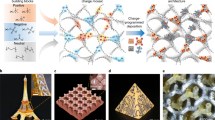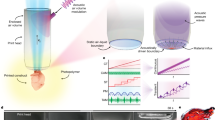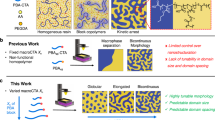Abstract
Light- and ink-based three-dimensional (3D) printing methods allow the rapid design and fabrication of materials without the need for expensive tooling, dies or lithographic masks. They have led to an era of manufacturing in which computers can control the fabrication of soft matter that has tunable mechanical, electrical and other functional properties. The expanding range of printable materials, coupled with the ability to programmably control their composition and architecture across various length scales, is driving innovation in myriad applications. This is illustrated by examples of biologically inspired composites, shape-morphing systems, soft sensors and robotics that only additive manufacturing can produce.
This is a preview of subscription content, access via your institution
Access options
Subscribe to this journal
Receive 51 print issues and online access
We are sorry, but there is no personal subscription option available for your country.
Buy this article
- Purchase on SpringerLink
- Instant access to full article PDF
Prices may be subject to local taxes which are calculated during checkout






Similar content being viewed by others
References
Swainson, W. K. Method, medium and apparatus for producing three-dimensional figure product. US patent 4,041,476 (1977).
Kodama, H. Automatic method for fabricating a three-dimensional plastic model with photo-hardening polymer. Rev. Sci. Instrum. 52, 1770–1773 (1981).
Hull, C. W. Apparatus for production of three-dimensional objects by stereolithography. US patent 4,575,330 (1986).
Sachs, E. M., Haggerty, J. S., Cima, M. J. & Williams, P. A. Three-dimensional printing techniques. US patent 5,205,055 (1993).
Beaman, J. J. & Deckard, C. R. Selective laser sintering with assisted powder handling. US patent 4,938,816 (1990).
Crump, S. S. Apparatus and method for creating three-dimensional objects. US patent 5,121,329 (1992).
Bradshaw, S., Bowyer, A. & Haufe, P. The intellectual property implications of low-cost 3D printing. ScriptEd 7, 5–31 (2010).
Lipson, H. & Kurman, M. Fabricated: The New World of 3D Printing (John Wiley, 2013). This book provides an overview of 3D printing and its impact on society.
Morrison, R. J. et al. Mitigation of tracheobronchomalacia with 3D-printed personalized medical devices in pediatric patients. Sci. Transl. Med. 7, 285ra64 (2015).
Gupta, M. K. et al. 3D printed programmable release capsules. Nano Lett. 15, 5321–5329 (2015).
Malda, J. et al. 25th anniversary article: Engineering hydrogels for biofabrication. Adv. Mater. 25, 5011–5028 (2013).
Derby, B. Printing and prototyping of tissues and scaffolds. Science 338, 921–926 (2012).
Villar, G., Graham, A. D. & Bayley, H. A Tissue-like printed material. Science 340, 48–52 (2013).
Mannoor, M. S. et al. 3D printed bionic ears. Nano Lett. 13, 2634–2639 (2013).
Kolesky, D. B. et al. 3D bioprinting of vascularized, heterogeneous cell-laden tissue constructs. Adv. Mater. 26, 3124–3130 (2014). This paper demonstrates multimaterial 3D printing of soft materials with disparate chemical and mechanical properties.
Murphy, S. V & Atala, A. 3D bioprinting of tissues and organs. Nature Biotechnol. 32, 773–785 (2014).
Ma, X. et al. Deterministically patterned biomimetic human iPSC-derived hepatic model via rapid 3D bioprinting. Proc. Natl Acad. Sci. USA 113, 2206–2211 (2016).
Gissibl, T., Thiele, S., Herkommer, A. & Giessen, H. Two-photon direct laser writing of ultracompact multi-lens objectives. Nature Photonics 10, 554–560 (2016).
deGans, B.-J., Duineveld, P. C. & Schubert, U. S. Inkjet printing of polymers: state of the art and future developments. Adv. Mater. 16, 203–213 (2004).
Kong, Y. L. et al. 3D printed quantum dot light-emitting diodes. Nano Lett. 14, 7017–7023 (2014).
Rim, Y. S., Bae, S. H., Chen, H., De Marco, N. & Yang, Y. Recent progress in materials and devices toward printable and flexible sensors. Adv. Mater. 28, 4415–4440 (2016).
Kong, Y. L., Gupta, M. K., Johnson, B. N. & McAlpine, M. C. 3D printed bionic nanodevices. Nano Today 11, 330–350 (2016).
Jones, R. A. L. Soft Condensed Matter (Oxford Univ. Press, 2002).
Compton, B. G. & Lewis, J. A. 3D-printing of lightweight cellular composites. Adv. Mater. 26, 5930–5935 (2014).
Cumpston, B. H. et al. Two-photon polymerization initiators for three-dimensional optical data storage and microfabrication. Nature 398, 51–54 (1999). This paper lays the foundations for high-resolution 3D printing of soft materials.
Sun, C., Fang, N., Wu, D. M. & Zhang, X. Projection micro-stereolithography using digital micro-mirror dynamic mask. Sensors Actuators A 121, 113–120 (2005).
Tumbleston, J. R. et al. Continuous liquid interface production of 3D objects. Science 347, 1349–1352 (2015). This paper details a method for 3D printing of photopolymerizable resins at high speed.
Hansen, C. J. et al. High-throughput printing via microvascular multinozzle arrays. Adv. Mater. 25, 96–102 (2013).
Choi, J.-W., MacDonald, E. & Wicker, R. Multi-material microstereolithography. Int. J. Adv. Manuf. Technol. 49, 543–551 (2010).
Choi, J.-W., Kim, H.-C. & Wicker, R. Multi-material stereolithography. J. Mater. Process. Technol. 211, 318–328 (2011).
Hardin, J. O., Ober, T. J., Valentine, A. D. & Lewis, J. A. Microfluidic printheads for multimaterial 3D printing of viscoelastic inks. Adv. Mater. 27, 3279–3284 (2015).
Ober, T. J., Foresti, D. & Lewis, J. A. Active mixing of complex fluids at the microscale. Proc. Natl Acad. Sci. USA 112, 12293–12298 (2015).
Frutiger, A. et al. Capacitive soft strain sensors via multicore-shell fiber printing. Adv. Mater. 27, 2440–2446 (2015).
Kokkinis, D., Schaffner, M. & Studart, A. R. Multimaterial magnetically assisted 3D printing of composite materials. Nature Commun. 6, 8643 (2015).
Bartlett, N. W. et al. Robot powered by combustion. Science 349, 161–165 (2015). This paper highlights the ability to generate graded matrices for soft robots.
Zheng, X. et al. Design and optimization of a light-emitting diode projection micro-stereolithography three-dimensional manufacturing system. Rev. Sci. Instrum. 83, 125001 (2012).
Zheng, X. et al. Ultralight, ultrastiff mechanical metamaterials. Science 344, 1373–1377 (2014).
Meza, L. R. et al. Resilient 3D hierarchical architected metamaterials. Proc. Natl Acad. Sci. USA 112, 11502–11507 (2015).
Frenzel, T., Findeisen, C., Kadic, M., Gumbsch, P. & Wegener, M. Tailored buckling microlattices as reusable light-weight shock absorbers. Adv. Mater. 28, 5865–5870 (2016).
Kinstlinger, I. S. et al. Open-source selective laser sintering (OpenSLS) of nylon and biocompatible polycaprolactone. PLoS ONE 11, e0147399 (2016).
Derby, B. Inkjet printing of functional and structural materials: fluid property requirements, feature stability, and resolution. Annu. Rev. Mater. Res. 40, 395–414 (2010).
Fromm, J. E. Numerical calculation of the fluid dynamics of drop-on-demand jets. IBM J. Res. Dev. 28, 322–333 (1984).
Lewis, J. A. Direct ink writing of 3D functional materials. Adv. Funct. Mater. 16, 2193–2204 (2006).
Zein, I., Hutmacher, D. W., Tan, K. C. & Teoh, S. H. Fused deposition modeling of novel scaffold architectures for tissue engineering applications. Biomaterials 23, 1169–1185 (2002).
Farahani, R. D., Dubé, M. & Therriault, D. Three-dimensional printing of multifunctional nanocomposites: Manufacturing techniques and applications. Adv. Mater. 28, 5794–5821 (2016).
Gratson, G. M., Xu, M. & Lewis, J. A. Direct writing of three-dimensional webs. Nature 428, 386 (2004).
Clausen, A., Wang, F., Jensen, J. S., Sigmund, O. & Lewis, J. A. Topology optimized architectures with programmable Poisson's ratio over large deformations. Adv. Mater. 27, 5523–5527 (2015).
Shan, S. et al. Multistable architected materials for trapping elastic strain energy. Adv. Mater. 27, 4296–4301 (2015).
Gladman, A. S., Matsumoto, E. A., Nuzzo, R. G., Mahadevan, L. & Lewis, J. A. Biomimetic 4D printing. Nature Mater. 15, 413–418 (2016).
Therriault, D., Shepherd, R. F., White, S. R. & Lewis, J. A. Fugitive inks for direct-write assembly of three-dimensional microvascular networks. Adv. Mater. 17, 395–399 (2005).
Wu, W., Deconinck, A. & Lewis, J. A. Omnidirectional printing of 3D microvascular networks. Adv. Mater. 23, H178–H183 (2011).
Herschel, W. H. & Bulkley, R. Konsistenzmessungen von Gummi-Benzollösungen. Kolloid Z. 39, 291–300 (1926).
Farahani, R. D., Lebel, L. L. & Therriault, D. Processing parameters investigation for the fabrication of self-supported and freeform polymeric microstructures using ultraviolet-assisted three-dimensional printing. J. Micromech. Microeng. 24, 055020 (2014).
Vidimce, K., Wang, S.-P., Ragan-Kelley, J. & Matusik, W. OpenFab: A programmable pipeline for multi-material fabrication. ACM Trans. Graph. 32, 136 (2013).
Muth, J. T. et al. Embedded 3D printing of strain sensors within highly stretchable elastomers. Adv. Mater. 26, 6307–6312 (2014). The paper details a method to create soft strain sensors embedded in elastomeric matrices.
Bhattacharjee, T. et al. Writing in the granular gel medium. Sci. Adv. 1, e1500655 (2015).
Brackett, D., Ashcroft, I. & Hague, R. Topology optimization for additive manufacturing. In Solid Freeform Fabrication Symposium 348–362 (2011).
Lin, D. et al. Three-dimensional printing of complex structures: Man made or toward nature? ACS Nano 8, 9710–9715 (2014).
Montemayor, L., Chernow, V. & Greer, J. R. Materials by design: Using architecture in material design to reach new property spaces. MRS Bull. 40, 1122–1129 (2015).
Wegst, U. G. K., Bai, H., Saiz, E., Tomsia, A. P. & Ritchie, R. O. Bioinspired structural materials. Nature Mater. 14, 23–36 (2015).
Launey, M. E., Buehler, M. J. & Ritchie, R. O. On the mechanistic origins of toughness in bone. Annu. Rev. Mater. Res. 40, 25–53 (2010).
Gibson, L. J. The hierarchical structure and mechanics of plant materials. J. R. Soc. Interface 9, 2749–2766 (2012).
Martin, J. J., Fiore, B. E. & Erb, R. M. Designing bioinspired composite reinforcement architectures via 3D magnetic printing. Nature Commun. 6, 8641 (2015). doi:10.1038/ncomms9641 This paper demonstates the power of combining 3D printing with external magnetic fields to produce oriented composite architectures.
Dimas, L. S., Bratzel, G. H., Eylon, I. & Buehler, M. J. Tough composites inspired by mineralized natural materials: Computation, 3D printing, and testing. Adv. Funct. Mater. 23, 4629–4638 (2013).
Matsuzaki, R. et al. Three-dimensional printing of continuous-fiber composites by in-nozzle impregnation. Sci. Rep. 6, 23058 (2016).
Schaedler, T. A. et al. Ultralight metallic microlattices. Science 334, 962–965 (2011).
Duoss, E. B. et al. Three-dimensional printing of elastomeric, cellular architectures with negative stiffness. Adv. Funct. Mater. 24, 4905–4913 (2014).
Hu, J., Meng, H., Li, G. & Ibekwe, S. I. A review of stimuli-responsive polymers for smart textile applications. Smart Mater. Struct. 21, 053001 (2012).
Felton, S., Tolley, M., Demaine, E., Rus, D. & Wood, R. A method for building self-folding machines. Science 345, 644–646 (2014).
Randall, C. L., Gultepe, E. & Gracias, D. H. Self-folding devices and materials for biomedical applications. Trends Biotechnol. 30, 138–146 (2012).
Liu, Y., Boyles, J. K., Genzer, J. & Dickey, M. D. Self-folding of polymer sheets using local light absorption. Soft Matter 8, 1764–1769 (2012).
Tibbits, S. 4D printing: Multi-material shape change. Architect. Des. 84, 116–121 (2014). This paper describes the first embodiment of 4D printing.
Raviv, D. et al. Active printed materials for complex self-evolving deformations. Sci. Rep. 4, 7422 (2014).
Ge, Q., Qi, H. J. & Dunn, M. L. Active materials by four-dimension printing. Appl. Phys. Lett. 103, 131901 (2013).
Ge, Q., Dunn, C. K., Qi, H. J. & Dunn, M. L. Active origami by 4D printing. Smart Mater. Struct. 23, 094007 (2014).
Mao, Y. et al. Sequential self-folding structures by 3D printed digital shape memory polymers. Sci. Rep. 5, 13616 (2015).
Mao, Y. et al. 3D printed reversible shape changing components with stimuli responsive materials. Sci. Rep. 6, 24761 (2016).
Burgert, I. & Fratzl, P. Actuation systems in plants as prototypes for bioinspired devices. Phil. Trans. R. Soc. A 367, 1541–1557 (2009).
Guo, Q. et al. Fast nastic motion of plants and bioinspired structures. J. R. Soc. Interface 12, 20150598 (2015).
Ilievski, F., Mazzeo, A. D., Shepherd, R. F., Chen, X. & Whitesides, G. M. Soft robotics for chemists. Angew. Chem. Int. Edn Engl. 50, 1890–1895 (2011).
Bauer, S. et al. 25th anniversary article: A soft future: From robots and sensor skin to energy harvesters. Adv. Mater. 26, 149–162 (2014).
Rus, D. & Tolley, M. T. Design, fabrication and control of soft robots. Nature 521, 467–475 (2015).
Yamada, T. et al. A stretchable carbon nanotube strain sensor for human-motion detection. Nature Nanotechnol. 6, 296–301 (2011).
Lu, N., Lu, C., Yang, S. & Rogers, J. Highly sensitive skin-mountable strain gauges based entirely on elastomers. Adv. Funct. Mater. 22, 4044–4050 (2012).
Lee, C., Jug, L. & Meng, E. High strain biocompatible polydimethylsiloxane-based conductive graphene and multiwalled carbon nanotube nanocomposite strain sensors. Appl. Phys. Lett. 102, 183511 (2013).
Majidi, C., Kramer, R. & Wood, R. J. A non-differential elastomer curvature sensor for softer-than-skin electronics. Smart Mater. Struct. 20, 105017 (2011).
Park, Y.-L., Chen, B. & Wood, R. J. Design and fabrication of soft artificial skin using embedded microchannels and liquid conductors. IEEE Sens J. 12, 2711–2718 (2012).
Chossat, J. B., Park, Y.-L., Wood, R. J. & Duchaine, V. A soft strain sensor based on ionic and metal liquids. IEEE Sens. J. 13, 3405–3414 (2013).
Sekitani, T. et al. A rubberlike stretchable active matrix using elastic conductors. Science 321, 1468–1472 (2008).
Matsuhisa, N. et al. Printable elastic conductors with a high conductivity for electronic textile applications. Nature Commun. 6, 7461 (2015).
Boley, J. W., White, E. L., Chiu, G. T. C. & Kramer, R. K. Direct writing of gallium-indium alloy for stretchable electronics. Adv. Funct. Mater. 24, 3501–3507 (2014).
Lee, H., Xia, C. & Fang, N. X. First jump of microgel: actuation speed enhancement by elastic instability. Soft Matter 6, 4342–4345 (2010).
Palleau, E., Morales, D., Dickey, M. D. & Velev, O. D. Reversible patterning and actuation of hydrogels by electrically assisted ionoprinting. Nature Commun. 4, 2257 (2013).
Ionov, L. Biomimetic hydrogel-based actuating systems. Adv. Funct. Mater. 23, 4555–4570 (2013).
Brown, E. et al. Universal robotic gripper based on the jamming of granular material. Proc. Natl Acad. Sci. USA 107, 18809–18814 (2010).
Anderson, I. A., Gisby, T. A., McKay, T. G., O'Brien, B. M. & Calius, E. P. Multi-functional dielectric elastomer artificial muscles for soft and smart machines. J. Appl. Phys. 112, 041101 (2012).
Suzumori, K. Elastic materials producing compliant robots. Rob. Auton. Syst. 18, 135–140 (1996).
Peele, B. N., Wallin, T. J., Zhao, H. & Shepherd, R. F. 3D printing antagonistic systems of artificial muscle using projection stereolithography. Bioinspir. Biomim. 10, 055003 (2015).
Robinson, S. S. et al. Integrated soft sensors and elastomeric actuators for tactile machines with kinesthetic sense. Extreme Mech. Lett. 5, 47–53 (2015).
MacCurdy, R., Katzschmann, R., Kim, Y. & Rus, D. Printable hydraulics: A method for fabricating robots by 3D co-printing solids and liquids. Preprint at http://arxiv.org/abs/1512.03744 (2015).
Wehner, M. et al. An integrated design and fabrication strategy for entirely soft, autonomous robots. Nature 536, 451–455 (2016).
Acknowledgements
We thank J. Raney, J. Muth and M. Skylar- Scott for their valuable insights, and the Wyss Institute for Biologically Inspired Engineering.
Author information
Authors and Affiliations
Corresponding author
Ethics declarations
Competing interests
J.A.L. is a co-founder of Voxel8, Inc., a 3D-printing start-up company. J.A.L. and R.L.T. have filed patents on work related to the 3D printing of soft sensors and robots.
Additional information
Reprints and permissions information is available at www.nature.com/reprints.
Reviewer information Nature thanks B. Derby and D. Therriault for their contributions to the peer review of this work.
Rights and permissions
About this article
Cite this article
Truby, R., Lewis, J. Printing soft matter in three dimensions. Nature 540, 371–378 (2016). https://doi.org/10.1038/nature21003
Received:
Accepted:
Published:
Issue Date:
DOI: https://doi.org/10.1038/nature21003
This article is cited by
-
A quirky fluid that has robotic capabilities
Nature (2024)
-
Piezomagnetic Behaviour of Wire Arc Additively Manufactured Steel Single-lap Shear Bolted Connections
Journal of Nondestructive Evaluation (2024)
-
Advancing CO2 separation: exploring the potential of additive manufacturing in membrane technology
Progress in Additive Manufacturing (2024)
-
Engineering Nano/Microscale Chiral Self-Assembly in 3D Printed Constructs
Nano-Micro Letters (2024)
-
Design, fabrication, and characterization of hierarchical mechanical metamaterials
Frontiers of Mechanical Engineering (2024)



